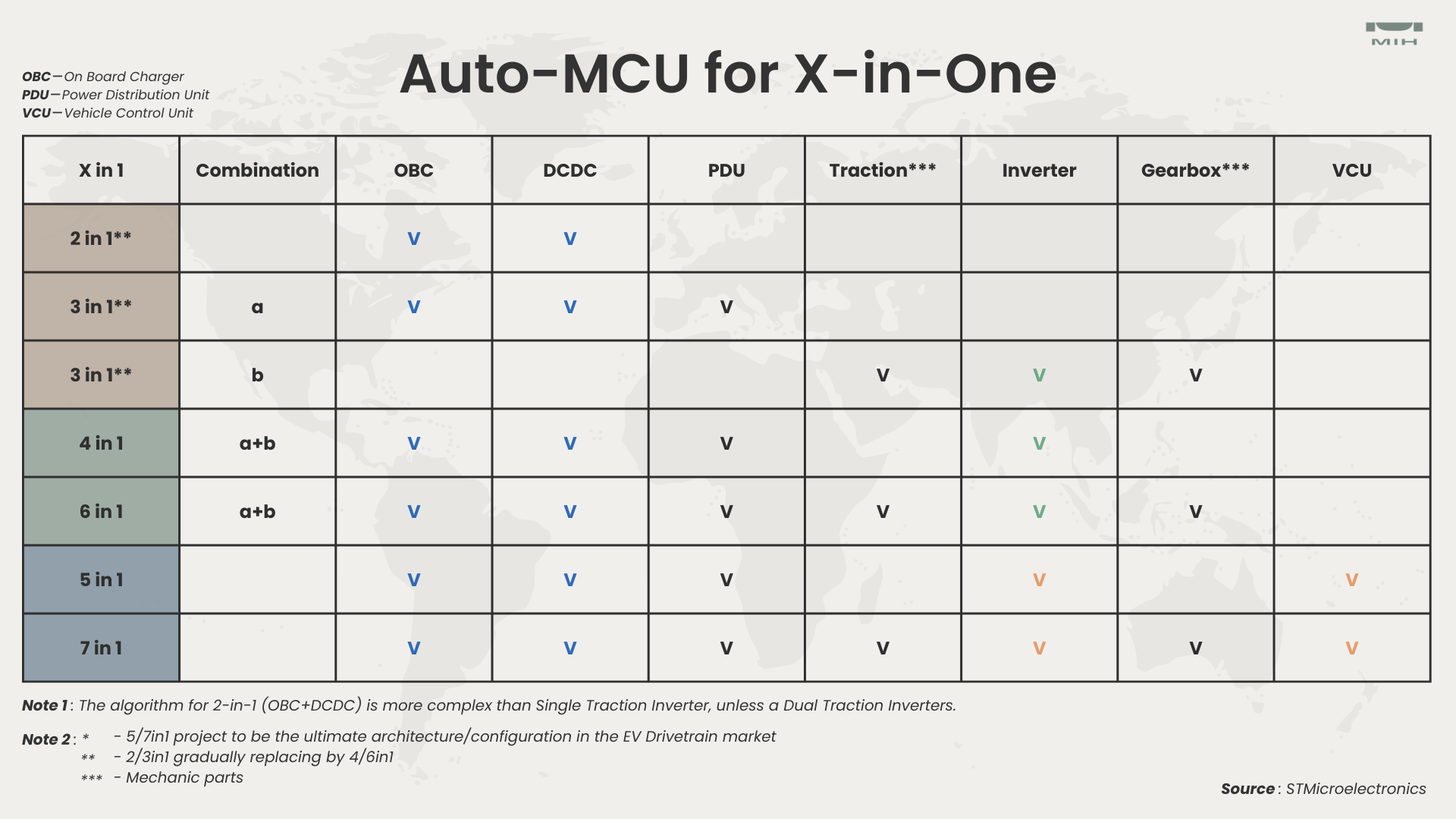What is the powertrain? In short, it is the internal machinery system of vehicles or boats. Take a vehicle as an example, powertrain generates power in the car, then transmits the power to the road to drive the vehicle forward. In other words, it is the system that generates, converts, and consumes energy to drive the vehicle.
The powertrain system consists of an engine, transmission, driveshaft, axles, differential, clutch, and other components. Since the powertrain system is an essential factor that determines the vehicle's operation, performance, and environmental protection while engaging many core technologies, it is a vital technology in the automotive industry.
The powertrain system of the traditional Internal Combustion Engine (ICE) car converts the energy of gasoline or diesel into kinetic energy in the engine. Then it transmits the energy to the wheels through a coordinated operation between the transmission, drive shaft, and differential to drive the vehicle forward. As vehicles move towards electrification, the types and configurations of powertrain systems have also changed, such as hybrid and all-electric vehicles. For all-electric vehicles, the powertrain is a key component that affects the power output performance of electric vehicles and the mileage that can be driven on a single charge.
The mission of the MIH Powertrain Working Group is to research and develop corresponding technologies based on the spirit of the MIH platform: Open and Agnostic. At this stage, the Powertrain Working Group has two main tasks.
The first is to align the two values mentioned above of MIH. By establishing a reference design, we can discuss which technologies in advanced systems are worth developing, and at the same time can develop into unique technologies as reference design topics.
The second is standardization and modularization. MIH believes that each component must possess a high degree of compatibility. For the reason that through the re-matching and combination, it can be applied to different styles or models of cars. Also, this high degree of flexibility helps partners build a diverse product portfolio and expand market opportunities. Regarding technology development, the Powertrain Working Group analyzed the trends and demands of passenger cars in the market. We believe that the three-in-one EDU with 2 Speed Gear Box is a competitive technology. In the passenger car market in the future, which requires satisfying both pull-back feelings while accelerating and mileage anxiety at the same time, the two-speed gearbox can give the best benefit without constantly upgrading the motor and battery specifications. At the same time, due to the greater flexibility of matching the motor and the battery, there is an opportunity to meet the demand for weight reduction, which in turn can make a greater contribution to energy consumption.
Currently, most electric vehicles use single-speed gearboxes, and only high-end vehicles use two-speed gearboxes. However, with the evolution of technology, two-speed gearboxes will be implemented in the general passenger car market in the future. Therefore, the working group primarily aimed at the trend of two-speed transmission and launched a three-in-one (motor, gearbox, and controller) design, and has now entered the Proof of Concept (POC) phase to validate actual energy efficiency data.
The members of the powertrain working group include international Tier 1 system suppliers, such as American Axle & Manufacturing (AAM), Inovance, etc., as well as parts suppliers with professional development capabilities, including Great Taiwan Gear, MinebeaMitsumi, Symbio, Vitalcore, JAE, INC, Sixxon, Nitto, Thaixon, Eternal Materials, Solvay, CQS, EMC, Drimaes, CHR Rubber, Topcco, Murata, Conquer, D&V, etc. Through the sophisticated component development capabilities of these partners, the Powertrain Working Group can take into account the supply chain needs at the system design stage and enhance the competitiveness of Taiwan's overall industry.
Another focus of the Powertrain Working Group is standardization and modularization. We will take the signal and interface as the first stage of the POC testing and confirm this technology is feasible, then we will engage in the subsequent discussion of standardization and modularization, and discuss the standardization of all interface specifications and the matching between modules according to the vehicle platform.
For example, when designing the three-in-one motor, gearbox, and control device, some companies do not necessarily produce complete three-in-one products, but some partial components. Hence, the advantage of standardization and modularization is that the products of the manufacturer can be matched with other companies to make a set or supply parts to Tier 1, or when the customer wants to replace one of the three-in-one products, the product does not need to be designed by the same company. It is highly flexible and will not be confined. Regarding the discussion and detailed formulation of standardization and modularization, the power system working group is expected to start in 2023 and will also be the focus of development next year.
In addition to the two significant tasks above, the Powertrain Working Group announced the establishment of a silicon carbide (SiC) sub-group in May this year. With the booming development of semiconductors and the trend of third-generation semiconductor technology, car manufacturers are beginning to manage chip supply. Therefore, while developing hardware technology, the powertrain working group specially set up a SiC sub-group to discuss the control components of kinetic energy chips. In terms of Powertrain, various reference designs can be discussed according to different model platforms and specifications, so some sub-groups focusing on other topics will be launched in the future. For example, in addition to the above-mentioned passenger car market, commercial vehicles, urban logistics, in-wheel motors, etc. will also be gradually discussed. Besides, the Powertrain is related to autonomous driving. Hence, the working groups under the MIH alliance, such as the powertrain and the AD/ADAS group, may also have joint projects to develop and integrate related technologies.
With the continuous development of electric vehicle technology, the development of power systems is also moving towards two trends. The first is the increase in motor speed. Most Tier 1 companies have invested in the research and development of high-speed motors. At present, most of the motor speed (RPM) on the market is 12,000-15,000RPM, and the focus in the next two years is to develop to 15,000-18,000RPM.
Evan some Tier 1 companies can already reach 20,000RPM even more. In the development process of these high-speed motors, there will be many technological breakthroughs, such as designing other components to match the high temperature and high pressure, etc. The second trend is electromechanical integration. For instance, the above-mentioned three-in-one, six-in-one, and even seven-in-one are all about electromechanical integration. How to achieve a well-integrated design in electromechanical integration and improve performance will be a key development trend.
The third trend is reducing the weight and volume of the hardware. It is foreseeable that this is the direction the whole industry will definitely take.

When developing models, one of the biggest challenges is the long vehicle development cycle. Take the example of the basic model of an automotive development strategy, the V model, which is a very rigid and time-consuming process, involving serialized tasks one after another. With standardization and modularization, agile co-development with professional partners will be the best strategy for new EV companies and startups. And this is the direction that the MIH Consortium is aiming at. MIH brings together partners from all over the world and increases overall efficiency by achieving future model development, component supply, and even production through its own specialized resources in the form of cooperation.
Undoubtedly, cars are one of the extremely complex products. Nowadays, the vehicle industry is moving towards electrification, MIH expects to bring opportunities to the automotive industry. In addition to assisting partners in cooperating with international Tier 1 companies, MIH also looks forward to the day when our partners can form their teams and become system integrators.
Last but not least, the MIH Consortium sincerely hopes to invite more partners to join in and work together with us for changing the mobility industry and realizing the vision of an open electric vehicle platform.
 I-Ru Huang, MIH VoC & UX Consultant
I-Ru Huang, MIH VoC & UX Consultant
10+ years of experience in Auto industry with experience across R&D/ Manufacturing/Branding. Leader of product improvement program based on VoC with global team based in China and US. One has deep understanding and is an expert in consumer insight and communication, who has taken Luxgen U6 earned top3 in IQS score in China rated by J.D. Power.
![[Expert Views] How Tesla Explores its Patent Assets](https://www.mih-ev.org/s3/mih%2Fwp-content%2Fuploads%2F2023%2F01%2FWispro-Expert-Views.png)
Wispro
2023-05-26

MIH Consortium
2023-03-20

MIH Consortium
2023-02-22